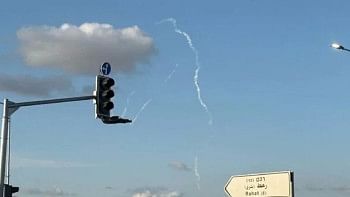Paschimbhag Copperplate: History engraved

In 1958, a copperplate inscription or grant named "Chandrapurasasana" (royal charter relating to Chandrapur) was found in Paschimbhag village of Rajnagar upazila in Moulvibazar.
It later became commonly referred as "Paschimbhag Copperplate", one of the 12 inscriptions from the Chandra dynasty found so far.
Eight of the copperplates are from during the reign of Srichandra. These are: Rampal plate, Kedarpur plate, Idilpur plate, Madanpur plate, Dulla plate, Bogra plate, a plate at Bangladesh National Museum and Paschimbhag plate. All of them are land grants (a grant of public land, especially to an institution, organisation, or to particular groups of people).
Paschimbhag plate is the most notable and discussed, as its inscription hints at a millennium-old higher learning centre in Rajnagar upazila of Moulvibazar.
In the article, "In search of a millennium-old higher-learning centre" published by The Daily Star on July 24, a researcher was quoted as saying that the inscription's whereabouts is currently not known.
On the day the report was published, Harold Rasheed, son of Ameenur Rasheed Choudhury, contacted this correspondent and informed that the copperplate has been well preserved over the decades.
TRACING THE COPPERPLATE'S LOCATION
Paresh Chandra Paul, a 90-year-old man from Paschimbhag village, said that he found the copperplate during excavation of a pond in 1958.
However, according to Kamala Kanta Gupta Choudhury (commonly referred as Kamalakanta Gupta) -- the decoder of the inscription and author of "Copper-plates of Sylhet" -- the inscription was accidentally found by one Binod Bihari Chakravarti in 1958 in a vacant land of Paschimbhag village.
The inscription was then passed on to the custody of Pandit Syamapada Kavyatirtha Bhattacharya of Bhumiuda village near Paschimbhag.
In September 1961, Sylhet Historical and Archaeological Society's member Ameenur Rasheed Choudhury, also editor of the daily Jugabheri newspaper from Sylhet, acquired the copperplate for the society from Pandit Syamapada Kavyatirtha Bhattacharya.
Kamalakanta Gupta then decoded the inscription on the copperplate by 1962.
In 1967, Kamalakanta Gupta in his book mentioned that the inscription was kept in the society's museum, but until recently its whereabouts was not clear to many researchers and to the Department of Archaeology.
Harold Rasheed told this correspondent that the copperplate was preserved in the family after the society was dissolved.
Later, on August 13 in 2017, it was handed over to Bhashasainik Matin Uddin Ahmed Museum at the Kendriya Muslim Sahitya Sangsad building in Dargah Gate area of Sylhet city, he said.
"The copperplate and the first original copy of Kamalakanta Gupta's book were protected by our family for decades before I handed those over to the museum, so that the items could be protected for long and can be displayed for everyone," Harold Rasheed said.
HISTORY ENGRAVED
Engraved on the copperplate "Chandrapurasasana" (royal charter relating to Chandrapur), are inscription of King Srichandra (also referred as Srichandradeva) -- the second ruler of south-eastern Bengal's Chandra dynasty -- which refers to millennium-old ancient mathas (monasteries or cloisters) in Srihatta (in present day Sylhet division), where students used to come for higher learning from scholars.

The inscription also mentions an ancient boat anchorage or naval port in the middle of Srihatta which was established on nearly 2,600 acres.
Inscriptions engraved on copperplates are historical legal records issued by ancient kings, and often came along with royal seals.
Centuries ago, such royal charters were used for the purpose of donations or legal registration of land grants to monasteries, people among other reasons.
King Srichandra ascended the throne after his father, King Trailokyachandra, established the kingdom based at Rampal of Vikrampur (present day Bikrampur in Munshiganj) in the early 10th century.
Srichandra was probably the most famous and successful of the five generation of kings of the Chandra dynasty, having ruled for 45 years from 930 AD to 975 AD, according to eminent historian Professor Dr Abdul Momin Chowdhury's book "Dynastic History of Bengal".
A total of 12 copperplate inscriptions from Srichandra's reign have been found so far, of which eight bear his seal.
Kamalakanta Gupta authored a book titled "Copperplates of Sylhet", published in 1967, where he describes the inscription as "A single plate engraved on both sides measuring 17.5 inches by 12 inches. A seal is attached to the top (in the middle portion) from which it projects about 5 inhes and causes a break in the middle of first two lines of obverse and first two lines of the reverse".
"The seal attached is 'Dharmachakramudra' or the emblem of the Wheel of Law. It consists of a number of concentric circles… a wheel flanked on two sides by two gazelles that symbolise the first move of the Wheel of Law by the Lord Buddha at Mrigaya. Below the representation is the legend 'Sri-Srichandradevah' across the seal," he wrote.

"The weight of the plate together with the attached seal is about 24 lbs. The writing consists of 65 lines of which 28 lines are inscribed on the front side and 37 lines on the reverse," the author also wrote.
"The characters are a type of Northern Nagari that was prevalently used in this part of the subcontinent in the 10th-11th century AD. The language is Sanskrit," Kamalakanta wrote in the book.
WHAT THE INSCRIPTIONS SAY
The Paschimbhag copperplate inscription was issued by King Srichandra approximately during the year 935 AD.
Although engravings narrate family history of the king, his father's conquest and many other incidents, the main reason of the inscription was for land grant.
According to Kamalakanta Gupta's decoded version of the copperplate, the king donated all the lands of Chandrapur, Garala and Pogara vishayas (districts) within Srihattamandala (Srihatta division) under Paundravarddhanabhukti (Paundravarddana province).
The first plot of land covering 120 patakas was granted in connection with the Chandrapuramatha (Matha of Chandrapur). Of those, 10 patakas were granted for the upadhyaya (teacher or guru) of the Chandragomin's (Buddhist scholar) consciousness and the rest were for 10 students, feeding of 5 Brahmans, for the makers of the temple, and other professionals connected to the matha.
The second plot, of 280 patakas, was granted in connection with the four desantariya (foreign) mathas and four vangala (Bengal) mathas.

For each matha, there was one upadhyaya who was also granted 10 patakas of land. Land was allotted to students, Brahmans, and some other professionals along with Baidya (healers).
All the remaining land -- except the 400 patakas for mathas and another 52 patakas of land reserved for Indresvaranaukabandha (Indresvara Boat Anchorage) -- was given to Gargga and other six thousand Brahmans, in equal shares, mentioning names of 37 in the inscription.
Though the royal charter or the copperplate inscription's original purpose was to grant land, it provides ample information about the history, geography, demography, religion, lifestyle, language and more.
According to the Paschimbhag copperplate inscription and the others from the time of King Srichandra, the dynastic history of the Chandras was cleared by the historians along with the victories of his father King Trailokyachandra, who conquered ancient Kamrupa (present day Assam).
THE LOCATION OF THE DONATED LAND
According to the copperplate inscription, King Srichandra donated all lands of Chandrapura and minor Garala and Pogara vishayas, which together were commonly referred to as Chandrapur.
The boundaries of Chandrapur, as said in the inscription, were: Virhat Kottali on the east; river Mani on the south; Jujjnakhataka, Kashthapannyakhataka and the Vetra-Ghanghi river on the west; and river Koshiyara on the north.
Kamalakanta deciphered that the Virat Kottali means a fort or stronghold on a ridge, probably the Adamail (present day known as Pathariya) hill grounds of Moulvibazar, Mani is present day Manu river, Koshiyara is present day Kushiyara river and the west boundary marks are several old canals or waterbodies flowing in the haor areas of eastern side of present day Habiganj.
Based on his research on this copperplate and several other copperplates and documents, Kamalakanta created a map of Chandrapur, which had an area of around 1,000 square miles or 6.4 lakh acres approximately.
According to Kamalakanta, Chandrapur Vishaya or district included whole of Moulvibazar's Sadar, Kulaura, Rajnagar, Barlekha, and Juri upazilas along with parts of Srimangal and Kamalganj; parts of Sylhet's Fenchuganj, Golapganj, Beanibazar, and Balaganj; parts of Habiganj's Nabiganj, Bahubal, Chunarughat and Aushkandi; and Dharmanagar and Kailasar in India's Tripura state.
WHERE IS THE COPPERPLATE NOW?
"The copperplate, along with the first original copy of Kamalakanta Gupta's book "Copper-plates of Sylhet" is now in the Bhashasainik Matin Uddin Ahmed Museum", Dr Mustafa Shahzaman Chowdhury Bahar, founder and director of the museum, confirmed to The Daily Star.
"We are displaying the copperplate on a wall," he said, adding "It was not missing, but was protected by a respected family. And Harold Rasheed generously handed it over to the museum."
"We welcome researchers-historians-archaeologists and others to visit the museum and examine this piece of history that speaks of our past," Dr Mustafa added.






Comments